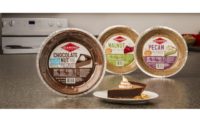Ready, Set, Bake
By Kathie Canning
Bakery mixes, concentrates and bases slash time and money.
Forget what your mother told you. Sometimes it’s OK to cheat. Not by counting cards or exaggerating tax deductions, of course. But a few shortcuts are perfectly acceptable — even preferred — when it comes to baking up the perfect dinner roll or croissant.
Bakery mixes, bases and concentrates give bakers the cheating tools they need to save time and money in numerous applications.
Cheat a Little ... or a Lot
The ultimate baking shortcut is the baking mix — a dry powder blend that usually requires little more than water to become a batter or dough. Such mixes can slash prep time while boosting consistency.
Bakers spend little to no time weighing ingredients, says Dick Myers, national accounts manager for Blendex Custom Blending Co., Louisville, Ky. Moreover, because most ingredients are included in one bag, in the proper proportions, bakeries require less inventory storage space.
“A baker generally adds just water to a complete mix, versus as many as 20 ingredients in a scratch formula,” Myers notes. “Thus, the likelihood of mistakes in weighing out ingredients [is reduced]. This is a convenience that is cost-effective.”
Bakery mixes not only provide a high level of convenience, but also can contain ingredients that boost nutritional value or perform specific functions, says Bernhard Barta, president and CEO of Glen Allen, Va.-based backaldrin of America LLC. It is difficult for bakeries to develop these types of mixes themselves, he adds.
“Just in the last 20 years, thousands of new raw materials have come on the market,” Barta notes. “It takes specific knowledge of the features of these products to properly apply them. Bakers get the finished product that best suits their needs without having to do intensive research and without carrying a huge raw materials inventory.”
In many cases, complete mixes are sold not to wholesale bakers, but to small retailers lacking skilled labor, says Werner Simon, technical sales service manager for Caravan Ingredients of Totowa, N.J. The exception might be a mix such as whole grain or organic that is too difficult to make otherwise.
“Complete mixes may be convenient, but the added overhead, re-bagging, freight and markup can erode your profits,” stresses Bob Lunde, national sales manager for Key Mix Corp. of Sykesville, Md. “A variety of products from a single concentrate can reduce inventory. Why pay inflated prices for ingredients in a mix when you can buy them cheaper locally?”
The concentrates to which Lunde refers essentially are blends of active ingredients such as enzymes, emulsifiers and flavors needed to optimize baking applications.
Dough concentrates allow bakeries to combine the convenience of mix-type products with specific cost savings, says Myers. Usually available in plastic or paste forms, they contain nearly everything required for the finished product except commodities such as flour, sugar and shortening.
Moreover, bakeries can create a variety of products from a single concentrate. From just one Key Mix concentrate, for example, bakeries can make cherry, blueberry, chocolate and many other doughnut varieties.
“Concentrates offer the best in cost savings, especially for large wholesale bakers,” Myers says.
The drawbacks? Concentrates necessitate a bit more time and skill in weighing and mixing the commodity ingredients.
Falling somewhere in between complete mixes and concentrates are bases. These offerings build on concentrates by incorporating ingredients such as sugar and shortening.
Although not as complete or foolproof as mixes, bases still allow bakeries to add some (less costly) fresh ingredients such as flour, potentially improving finished product quality, says Myers.
In most cases, Simon notes, the base will include the “complete engine” for the desired product, including salt, sugar and oxidation ingredients.
“A typical base for a Kaiser roll, for instance, would be between 5% and 9%, and would require only water, flour and yeast,” he says. “[In contrast], a concentrate may be as low as 1% and may contain a combination of the most important ingredients for the desired product.”
Base advantages, Simon adds, include reduced purchase and storage requirements for many minor ingredients.
With dough bases, bakeries also can be more flexible in adding flours such as whole wheat, rye and more, Myers says. Bases often serve as partial mixes, he adds, offering similar advantages in cost-effectiveness, consistency and convenience.
Bakers also benefit from dough improvers within or added to mixes, concentrates and bases. These conditioners modify the gluten structure of the dough, optimizing product quality.
Today’s bakeries have access to a wide variety of dough improvers, Barta says, to achieve everything from a crispy skin/soft crumb to a soft skin/short bite.
Seek Out Advice
With so many options, some bakers might need guidance in selecting — and using — the right mix, base or concentrate.
A particular bakery might select a concentrate, for example, when it would be better off choosing a base, says Simon.
“In general, a mix company like Caravan will work with the customer to make sure that the right product is chosen,” he says. “The bottom line is usually bowl cost, and if everything else is taken into account, the most tolerant product with the least chances for error in manufacturing should be selected.”
Because not all wholesale bakers are food technologists, Myers says, “they often purchase flours that have conflicting protein, moisture and ash contents with the bases and concentrates they purchase from a mix manufacturer. Other times, bakers will change the ratio of flours, sugar, shortening and eggs, differing from manufacturer’s recommendations.”
To reap the best results, therefore, wholesale baking supervisors should form close relationships with the R&D personnel and technical representatives from their supplier companies, he adds. Communication will ensure they get the information needed to make desired formula changes.
Bakeries also should use concentrates that are custom-formulated for their equipment, Lunde notes. Key Mix has the technical expertise to custom-formulate its offerings for each bakery’s specific equipment needs.
Brolite Products of Streamwood, Ill., also boasts an experienced R&D staff that works in partnership with bakeries to custom-formulate blends. In addition, the company provides ongoing technical support to help sales grow.
New Cheating Tools
As consumer tastes change and expand, wholesale bakeries continue to augment their product mix. And mix, base and concentrate suppliers are ready with modern “cheating tools” geared toward consumer trends and bakery needs.
“Many customers are demanding more whole grain foods, but they also demand flavor,” Lunde says. Key Mix has introduced a number of whole wheat mixes and concentrates to ease prep work for items such as doughnuts, honey buns and Danish.
Caravan, too, is addressing demand for whole grains — as well as for organic and nutritionally “clean label” offerings — with cake bases/mixes such as a certified whole grain VitoGrain, Half & Half Honey Whole Grain, Super Soaked Whole Grains and Six Grains Plus, Simon explains. In addition, the company has launched trans-fat-free bases, mixes and concentrates for sweet applications and more.
New from Blendex are a no fat/no sugar/no cholesterol muffin mix, a Kentucky mash bread mix, a Kentucky mash biscuit mix and a Kentucky Mash Pancake mix.
“We have also crossed over into the yeast-raised and cake doughnut mix market,” Myers says. “The mash products are very new, and we are excited about the possibilities with those products. We do proprietary yeast and cake doughnut mixes, along with our regular yeast and cake donut mixes.”
Backaldrin of America is a new subsidiary of backaldrin International GmbH, a European bread mix and dough improver manufacturer. Among its latest offerings are the Pur Pur mix and the Sacher mix. The former adds what Barta calls a “unique appearance, texture and taste” to sweet goods and other products, while the latter is a high-end product that imparts a delicate flavor to baked goods.
Regardless of the mix, base or concentrate, for many bakers, the results are worthwhile. Who said cheaters never win?
Goodbye, High Cholesterol
Bread now can do more than just taste great and look pretty — it also can reduce consumers’ cholesterol levels. Using a unique technology with beta glucan-rich oat bran, Cherry Hill, Pa.-based Puratos USA can provide bakeries with the tools to create Cholesterol Lowering Bread.
Bread produced with the Puratos solution can carry a Food and Drug Administration claim that states: “Three grams of soluble fiber daily from oat bran in a diet low in saturated fat and cholesterol may reduce the risk of heart disease.” Puratos says its Cholesterol Lowering Bread recipes are formulated to deliver 75 g. of Beta glucan soluble fiber from oat bran per 50-g. serving.


